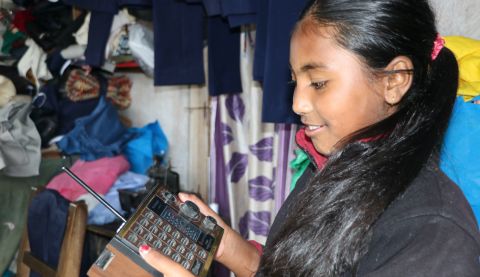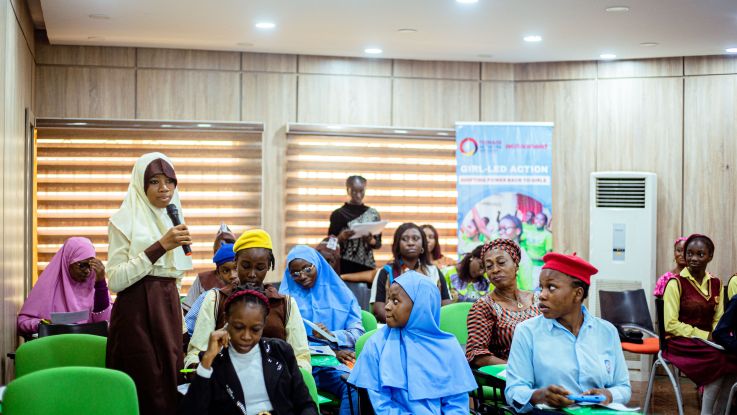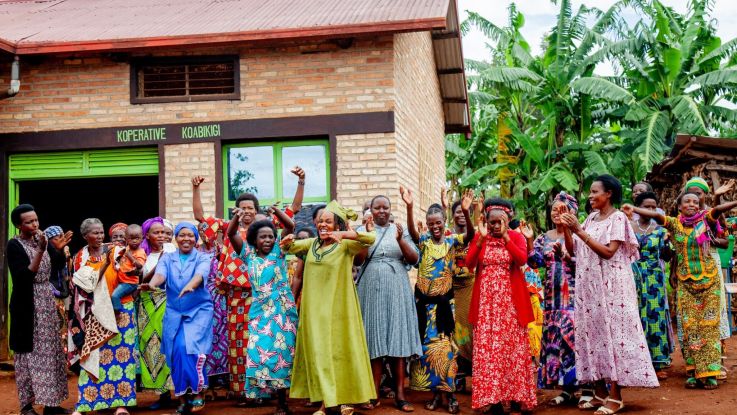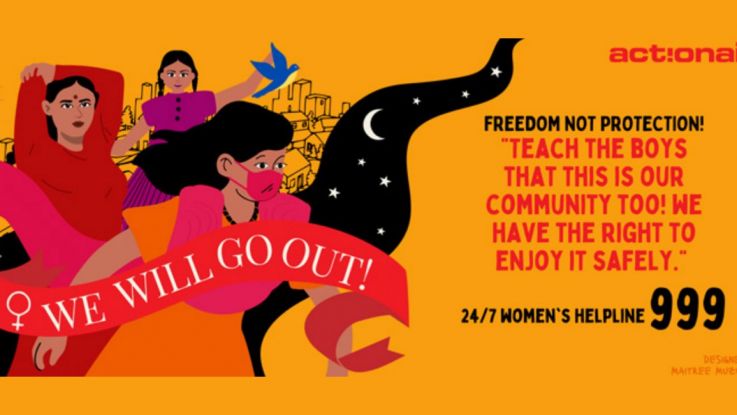10 ways to protect education for the Covid-19 generation
22 January 2021
Education must not be a casualty of the Covid-19 crisis.
Millions of children around the world are being affected by the coronavirus crisis and we need to make sure we don't roll back on children's rights and years of progress in advancing girls' rights.

8-year-old Krijana learnt all about the coronavirus through radio programmes in Nepal. Photo: Umesh Nepali/ActionAid
One year into the Covid-19 pandemic, we already know the devastation caused by the coronavirus crisis at home and all over the world.
This year the coronavirus pandemic is still raging across the world. Many countries continue to struggle with the balancing act of containing the virus and preventing the deaths of their citizens with managing their declining economies and infrastructures.
While the full, long-term impacts of the pandemic yet to be examined, the disruption caused to the education of millions of children is already becoming clear.
While state lockdowns mean short-term school closures for some, for many of the children around the world lockdowns and the knock-on economic effects of the pandemic signify falling behind or an indefinite end to their education."
Worldwide, nearly 11 million primary and secondary school children, including 5.2 million girls are predicted to drop out of school this year alone according to the latest report by the United Nations Educational, Scientific and Cultural Organisation (UNESCO).1 Almost half of these children are in South and West Asia and sub-Saharan Africa.
While state lockdowns mean short-term school closures for some, for many of the children around the world lockdowns and the knock-on economic effects of the pandemic signify falling behind or an indefinite end to their education. This threatens not only children's right to education but the reversal of the years of progress made to ensure equal access to learning for all. A setback of girls’ right to education is particularly alarming.
How school closures affect girls
If school closures are further extended, the most vulnerable students, such as girls living in poverty may never return.
Factors like supporting families with income, rise in unpaid household work, care responsibilities, child marriage, early pregnancy and little to no access to remote learning can further contribute towards them never setting a foot again in a classroom.
When schools are closed, vulnerable children and youth miss out on regular school meals and social protection services, as well as access to safe spaces for girls to voice their concerns and solutions to the challenges they face – often in the form of girls clubs."
And, no school brings more risk for girls especially. As the Covid-19 virus spreads, millions of girls find themselves confined at home, isolated and vulnerable to abuse, neglect and violence.
For many girls, education, schools and girls' clubs are a life-line, offering protection from harm and the potential for a brighter future.
As we saw during the Ebola crisis in 2014, school closures increased girls’ vulnerability to physical and sexual abuse both by their peers and by older adults2, as girls were often at home alone and unsupervised.
In Sierra Leone, adolescent pregnancy was estimated to have increased by up to 65% in some communities during the Ebola crisis3, as a result of being outside the protective environment of schools.
In addition, when schools are closed, vulnerable children and youth miss out on regular school meals and social protection services, as well as access to safe spaces for girls to voice their concerns and solutions to the challenges they face – often in the form of girls clubs.
While global attention is understandably focused on the functioning of health systems, ensuring people recover and the spread of the virus is contained, we should not lose sight of the importance of education during this crisis.
Right now, we know that providing cash assistance helps households meet basic needs such as food and helps to ensure that families have resources to keep girls in education such as transport and school materials. Catch-up classes during lockdowns have also been critical to help students get back on track.
This pandemic offers an opportunity to step up and revitalise education to be more inclusive and transformative for the lives of millions of children around the world.
Here are 10 ways we can work to persevere through the crisis and safeguard children's right to education.
1. Ensure free, quality, public education that is accessible to all children
We ask decision-makers to guarantee education for all by adopting appropriate distance learning methods and consider low-tech or no-tech options for those with no digital access.
Teaching timetables and learning plans should be flexible and allow for self-paced learning so as not to deter girls who often disproportionately shoulder the burden of care.
Accessible learning can include sending reading and writing materials home and using radio broadcasts to reach the poorest or most marginalised.
Learning material should also cover reliable, accurate and readily understandable information on Covid-19 to prevent and control the spread of coronavirus.
2. Safeguard vital services such as meal provisions
Governments and local authorities could help by ensuring schools continue to serve as places for psychological help, social support and food distribution.
Or at least alternative social services may be provided and delivery of support over the phone, text or other forms of media should be considered ensuring the safety of the children and those delivering the services.
3. Secure child protection and sexual and reproductive health
Ensure messages about child protection, referral and other support services are available to children.
Age-appropriate information on sexual reproductive health rights and education should also be included in distance-learning packages for children and young people.
4. Ensure that all children are adequately prepared for examinations
Where examinations were postponed, allow children enough time to prepare for the examinations so that even those who were unable to access distance learning are able to catch up and are not left behind.
Remedial classes and extra lessons with teacher support should be considered.
Positive discrimination for disadvantaged children should be planned for in order to address the imbalance that may have increased during school closures
5. Prepare for the safe return of all children to school
Provide flexible learning approaches so that girls and other marginalised children are not deterred from returning to school when they re-open.
This includes pregnant girls and young mothers who often face stigma and discrimination on re-entering school that prevent them from accessing education.
Where educational facilities have been used as emergency treatment centres, a thorough clean-up for a quality, safe learning environment should be done.
Ensure education and health services are working together to ensure conditions are safe for children and teachers to return to school.
6. Ensure immediate support for teachers
This crisis should not allow us to lower our standards or push aside labour rights.
The salaries and benefits of teaching and education support staff must be protected.
Measures to guard and support teachers’ health and well-being must be put in place as they cope with the pressures of ensuring continued learning during a time of heightened anxiety.
7. Make long-term investments in the teaching profession
Sub-Saharan Africa has the greatest teacher shortages in the world, leading to severely over-crowded classrooms where safe social distancing is impossible. More trained teachers are urgently needed.
Without an adequate number of motivated teachers, countries will be unable to train future doctors and nurses to face upcoming emergencies.
This pandemic has seen an increased appreciation of teachers from parents across the globe. This needs to be recognised, ensuring that the profession is valued and teachers are paid a living wage.
Continuous professional development opportunities will also ensure teachers are well-equipped to support distance learning and actively participate in the response to this and future pandemics.
8. Funding for education in emergencies
Ensure education has space within the government’s crisis plans and that funds are set aside for education during emergencies, including pandemics. Education budgets should be protected and not cut during this pandemic.
Donors should prioritise aid towards education, including in emergencies, making sure they harmonise efforts, leverage domestic financing and support government plans.
9. Remove restrictions on poorer countries
International Monetary Fund (IMF) should remove constraints on governments that limit the number of key public sector workers such as teachers and medical staff that governments can recruit to adequately respond to the pandemic.
This should be a central part of a move away from decades of austerity, recognising that investments in key public services like education are key to achieving the United Nation's sustainable development goals (SDGs).
Rather than cutting spending, the priority should be for governments to raise more revenue through tax in a fair way.
10. Cancel debt in 2021 and 2022
ActionAid believes that IMF and all other lenders should cancel all debt throughout 2021 and 2022, allowing countries to free up resources to respond to the pandemic.
During this period there needs to be a new global debt system agreed to ensure that no country has to spend more on paying old debts than what they should be doing - investing in health and education.
ActionAid's Call to Action on the urgent work needed to support education after the pandemic has been signed by 190 leading organisations worldwide.
Sponsor a child to continue their education
All children should have an equal chance to thrive despite the global pandemic.
As we start this new year with the coronavirus crisis reaching its peak, let's ensure no child gets left behind.
We know that we can make small differences to protect and empower children. When you sponsor a child you can help us ensure children continue their education while at home through ActionAid's community classes and radio programmes.
Your sponsorship will make a huge difference to a child in need – giving him or her a chance of a better future.
Sponsor a child today and see for yourself the difference your support can make.



